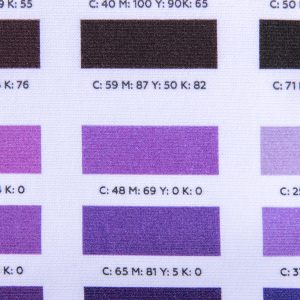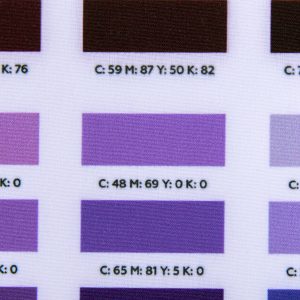What is the difference between pigment printing and sublimation printing?
There are several important differences between pigment printing and sublimation printing that should be taken into account when choosing a specific printing method.
Pigment printing is a technology in which dyes are applied directly to the surface of a white material on which a special coating has been spread. Thanks to this coating, the dyes stick better on the surface of the textile. The result of pigment printing is a very detailed, clear and sharp image. Although the print is applied to the surface of the fabric or knit, it is not perceptible to the touch (in the case of darker prints fabrics can feel a bit stiff before the first wash), and it does not change the properties of the material in any way – knit fabrics remain elastic and all fabrics remain airy and soft. Complex tonal gradation can be easily achieved in pigmented printing. It is worth noting, however, that in pigment printing, the black colour won’t appear as a true, deep black. However, the pigment printing technology is environmentally friendly – no chemicals or water are used during printing and fixing of the printed materials, and in the print-on-demand model, only minimal textile waste is generated. Pigment printing, however, is not the most durable method of printing materials – note that pigment prints can be damaged when rubbed wet. The pigment printout fades slightly over time after repeated washing.
Sublimation is a printing technology in which dyes penetrate directly into the material’s structure, creating durable and imperceptible prints on the material. When the dye is directly bonded to the yarn of the fleece, even when strongly stretched, no white base fibre appears. In sublimation printing, the pattern is initially applied to the transfer paper, which is then placed on the fabric. In a special press, under the influence of temperature and pressure, the dyes sublimate and merge with the fibre of the material. Sublimation performed indirectly (i.e., using transfer paper) may result in a slight blurring effect or a slightly blurred printout. In sublimation printing, a minimal shift of the transfer paper on the material may cause a slight blur in the printout. Sublimation is a printing method that can be performed on 100% polyester or high-quality materials, min. 80% synthetic fibre content.
The first image depicts a colour map printed in pigment ink printing technology. The second one shows the same colour map printed in sublimation printing.



 Ready to print on fabrics with CottonBee?
Ready to print on fabrics with CottonBee? 